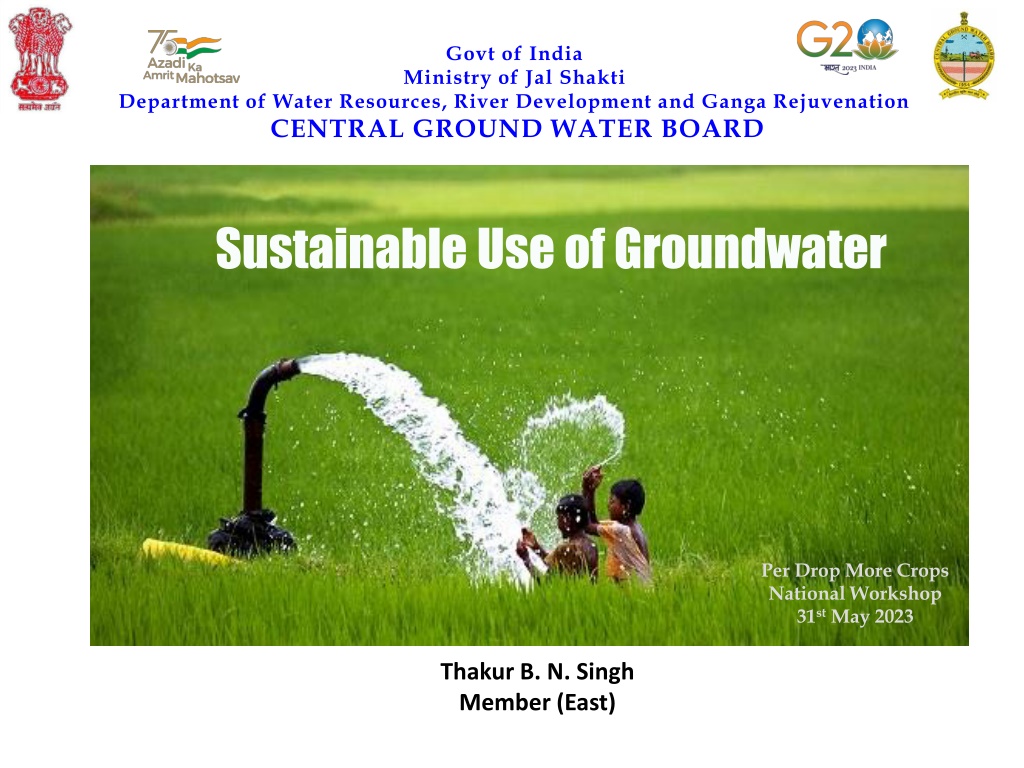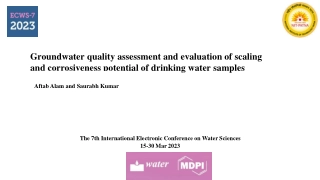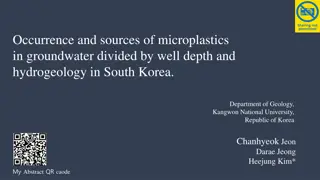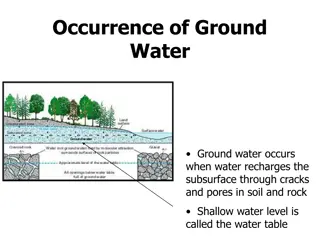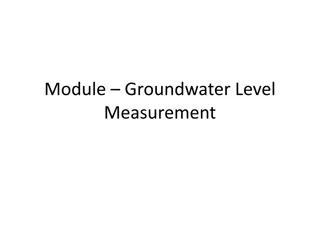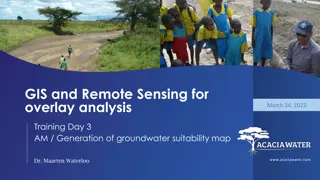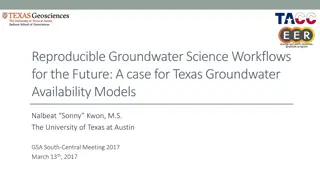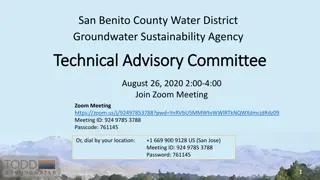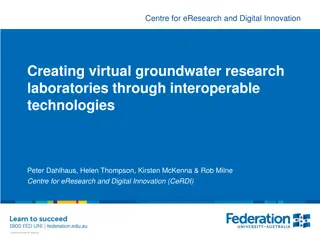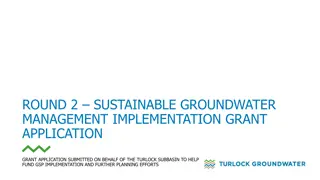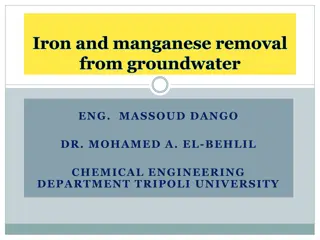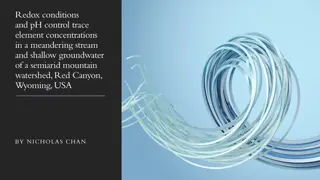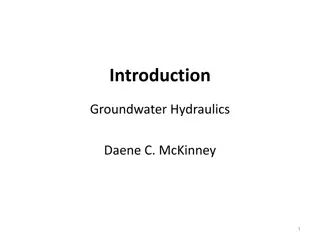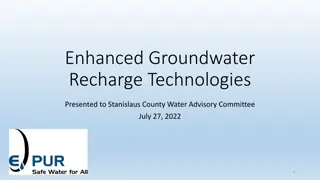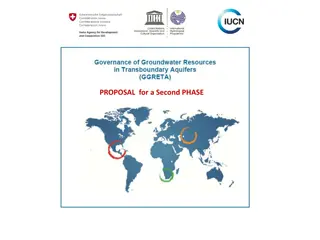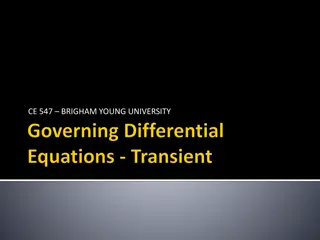Sustainable Use of Groundwater
Groundwater management and sustainable use are crucial in India, as highlighted by the Ministry of Jal Shakti. The country faces challenges such as declining groundwater levels, quality deterioration, and increasing demand-supply gaps. Effective strategies and responsible practices are needed to address these issues and ensure long-term availability of this vital resource.
Download Presentation

Please find below an Image/Link to download the presentation.
The content on the website is provided AS IS for your information and personal use only. It may not be sold, licensed, or shared on other websites without obtaining consent from the author.If you encounter any issues during the download, it is possible that the publisher has removed the file from their server.
You are allowed to download the files provided on this website for personal or commercial use, subject to the condition that they are used lawfully. All files are the property of their respective owners.
The content on the website is provided AS IS for your information and personal use only. It may not be sold, licensed, or shared on other websites without obtaining consent from the author.
E N D
Presentation Transcript
Govt of India Ministry of Jal Shakti Department of Water Resources, River Development and Ganga Rejuvenation CENTRAL GROUND WATER BOARD Sustainable Use of Groundwater Per Drop More Crops National Workshop 31st May 2023 Thakur B. N. Singh Member (East)
GROUND WATER OVERVIEW 239 BCM 398 BCM 60 % 437 BCM Total annual ground water recharge Annual extractable ground water resources Annual Ground Water extraction Stage of Extraction *Dynamic Ground Water Resources of India,2022 3
Groundwater Resources of India 2022 Categorization of Groundwater Resource Assessment units Total Assessment units 7089 Over exploited 1006 (14 %) Critical 260 (04%) Semi-critical 885 (12 %) Safe 4780 (67 %) Saline 158 (02 %) Domestic 11% Industrial 2% Irrigation 87%
GROUNDWATER USE IN AGRICULTURE 300 US China Sri Lanka Tunisia W.Europe India Vietnam Spain Pakistan Ghana Mexico Bangladesh South Africa 250 200 150 100 Increasing Stage Increasing Stage of GW Extraction of GW Extraction 50 0 1940 1950 1960 1970 1980 1990 2000 2010 80 63 62 62 61 58 60 India has over 20 million irrigation wells 0.8 million are being added every year. Every fourth cultivator owns an irrigation well. Non-owners depend on groundwater markets. 37 40 32 20 0
The sustainable use of Groundwater refers to the responsible and efficient management of this valuable resource to ensure its long-term availability Per Capita Water availability in m3/year Water Stress 1700 m3 year- 1 Per Capita Water Availability in India Water Scarcity 1000 m3 year-1 6
GROUND WATER USE Existing demands and Issues Growing demands for Agriculture,domestic and industrial water supply Groundwater table declining in many states Deterioration in Ground Water quality Gap in demand and supply of water resources increasing
MISMANGEMENT OF GROUNDWATER High water wastage Poor maintenance of pipelines and related leakage issues. Lack of water saving awareness. Unauthorized tap connections
Demand Side Management It works on Reducing the amount of water that is being used by stakeholders for its need. Supply-side Management Supply-side sustainable use of groundwater works by Increasing the amount of available water. 9 Ground water
Supply Side Management Artificial Recharge Rainwater Harvesting Collection and storage of Rainwater Accelerate or induce the process of infiltration by artificial means Infiltration depends on Restricting Run off Nature of the top soil (infiltration Capacity) Nature of the Rock (Permeability) Retention Time Contact Area
Supply side interventions and water conservation Supply side interventions and water conservation measures through demonstrative projects measures through demonstrative projects CGWB CGWB Aquifer rejuvenation projects in water stressed districts Master Plan for artificial recharge Aquifer rejuvenation projects in aspirational districts Innovative instream storage - Bridge cum Bandhara SOP on source sustainability
Demand Side Management Domestic sector Increasing Water use efficiency fixing leaky systems or upgrading existing infrastructure to reduce wastage Water Pricing /Water cess Water meter Dual pipe Water supply Agriculture sector Water use efficiency through drip/sprinkler irrigation Conjunctive use Less water consuming crops/Crop Rotation Setting up Water User association Grey water use for irrigation Industrial sector Adopting water saving technology Recycle and reuse of water in industrial process Desalination of saline water Capacity building and Public awareness Ground water Regulations Regulations, water charge, penalty and EC
Decrease water demand Sensor based efficient showers Water efficiency rating Price water as per use Recycle and Reuse Increase water source Water metering Meter water use Use dish washers Automatic faucets 13
Greywater is wastewater from non-toilet plumbing systems such as hand basins, washing machines, kitchen, showers and baths. Can be treated and reused instead of discharging out. Reusing grey water can decrease groundwater extraction.
Monitoring & Assessment Strengthening and automation of Strengthening and automation of groundwater monitoring network taken up groundwater monitoring network taken up By By 2026 2026, , CGWB CGWB plans automated automated monitoring monitoring stations the the telemetry telemetry system Under Under the the National National Hydrology 5260 5260 DWLRS DWLRS with installed installed. . Annual Annual Groundwater Groundwater assessment assessment is is being plans to to install stations with system Hydrology Project, with telemetry telemetry is is being install 9000 9000 with Project, being Resources Resources out being carried carried out
CGWA and Groundwater Regulation Impact Assessment Report Annual Water Audit Reports GW Charges, Penalty, EC RWH by industries abstracting GW > 100 m3/day by FICCI, NPC, CII All industries drawing GW of > 100 m3/day in OCS areas As per model building bye-laws. As per specified rates All industries shall be required to adopt latest water efficient technologies so as to reduce dependence on ground water resources (by at least 20% over the next three years)
CGWA and Groundwater Regulation Agriculture Sector: Agriculture sector is exempted from obtaining NOC for GW extraction with views of- Adopting Participatory approach for sustainable GW management Review free/ subsidized electricity policy to farmers Bringing suitable water pricing policy Working towards crop rotation/ diversification/ other initiatives to reduce over-dependence on groundwater.
NAQUIM and Aquifer Management Plan CGWB has carried out National Aquifer Mapping (NAQUIM) in the country and has suggested Aquifer Management Plans (AMP) for the districts. The NAQUIM outputs and the AMPs have been shared with the district authorities for implementation. Management Plans are being used for preparation of water security plans under Atal Bhujal Yojana Under PMKSY-HKKP-GW scheme, the concerned departments in states, especially NER states are using CGWB findings for planning groundwater based irrigation schemes.
Direct Seeded Rice (DSR) System of Rice Intensification in rice(SRI) Popularizing Micro Irrigation (MI) techniques Use of MI even in water-intensive crops with more focus on Sugarcane & Banana Other interventions like Pipe carrying water from source to field to avoid seepage Selection of low water-intensive crops Change in cropping pattern
